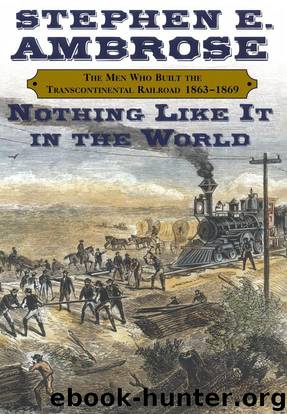Nothing Like It in the World: The Men Who Built the Transcontinental Railroad, 1863-1869 by Stephen E. Ambrose

Author:Stephen E. Ambrose [Ambrose, Stephen E.]
Language: eng
Format: epub
Tags: History
ISBN: 9780684846095
Google: k0av1ysNg0cC
Publisher: Simon and Schuster
Published: 2000-10-15T10:00:00+00:00
Chapter Eleven
THE CENTRAL PACIFIC PENETRATES THE SUMMIT 1867
IN 1867, the UP was coming on, a mile a day, two miles a day, sometimes three miles in a day, racking up miles, collecting the government bonds and selling its land grants. Before the year was over, it was penetrating Utah with surveyors, its grading crews were well into Wyoming, and its track layers were past Cheyenne. The company hoped that before 1868 was out it would have its end of track into Utah. Along with Durant and Dodge, its directors, surveyors, supervising engineers, construction bosses, and multitude of workers thought that the UP would lay track all the way to the California-Nevada border, where it would meet the CP and thus win the race.
In 1867, the CP was still short of the summit of the Sierra Nevada. Its progress was measured in yards, not miles. It was collecting no government bonds, it was not selling land grants, it could not sell much or even any of its own stocks and bonds. Meanwhile, it was spending tons of money. It looked likely that the UP would win the race.
The reason was obvious to any observer. The UP was laying track over a relatively flat country, while the CP was in some of the roughest mountains on the continent. The UP had to haul in ties, rails, food, forage, and more, upstream on the Missouri River, but from Omaha out to the west, it carried the supplies forward on its own railroad line. The CP had plenty of water and wood, but it had tunnels to drive through granite mountains. The UP could draw on the settled portions of the country for its workers. The CP had to rely, for the most part, on the Chinese. But if and when the CP emerged from the Sierra Nevada, it would be on the Truckee River and then the Humboldt, where it could make time in grading and track laying just as the UP was coming up against the Wasatch Range.
By 1868, both railroads would be far from their base. As Henry Poor, editor of the Railroad Journal, explained, “The operations of a railroad company are like those of an army, the cost and difficulty of the maintenance of which increase in inverse ratio as the scene of its action is removed from its base.” Only a completed railroad could supply the road under construction with its materials and labor force. Thus, Poor said, a given amount of work would cost “thrice as much and occupy thrice the time” for a railroad west of the Mississippi River as for one on the east side.1
In the first few months of 1867, the Chinese worked for the CP in gangs, in eight-hour shifts or sometimes longer, around the clock. They lived in quarters dug in the snow, going to work surrounded by snow. They usually operated in teams of three at a time at the tunnel facing, with four teams working side by side. Of the men
Download
This site does not store any files on its server. We only index and link to content provided by other sites. Please contact the content providers to delete copyright contents if any and email us, we'll remove relevant links or contents immediately.
| Automotive | Engineering |
| Transportation |
Rival Rails: The Race to Build America's Greatest Transcontinental Railroad by Walter R. Borneman(615)
The Trains Now Departed by Michael Williams(490)
Conquering Gotham by Jill Jonnes(482)
Abolition and the Underground Railroad in Vermont by Michelle Arnosky Sherburne(472)
Nothing Like It in the World: The Men Who Built the Transcontinental Railroad, 1863-1869 by Stephen E. Ambrose(452)
To the Edge of the World by Christian Wolmar(409)
The Collapse of Richmond's Church Hill Tunnel by Walter S. Griggs Jr. Walter S. Jr. Griggs(367)
Stealing the General by Russell S. Bonds(357)
Iron Horses by Walter R. Borneman(352)
Modelling the Great Western Branch Lines by Chris Ford(347)
A Historical Dictionary of Railways in the British Isles by David Wragg(340)
The Early Pioneers of Steam by Stuart Hylton(338)
Rails of War by Steven James Hantzis(329)
When Trains Ruled the Rockies by Terry Gainer(303)
The Journey Matters by Jonathan Glancey(293)
Cleveland Mainline Railroads by Craig Sanders(288)
Railway Architecture (Shire Library) by Bill Fawcett(264)
Tragedy at Southern Oregon Tunnel 13 by Scott Mangold(242)
The Iron Road in the Prairie State by Simon Cordery(216)
